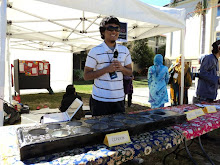Non standard measurement before standard measurement
Non standard measurement advocates the manipulation of classroom materials, natural material, body parts or classroom furniture to measure. This type of measurement should emphasize the development of comparative language such as 'more than', 'less than', 'bigger/ smaller than' and 'taller/ shorter than'.
is bigger than
using feet to measure length of an object e.g. land, wall, floor, etc.
In the workshop with Anne, we had the opportunity to measure many things using non-standard unit.
For example, using the area of a table to measure the area of the white board. We were using butch papers to represent the table and pasting the papers on the white boards. Finally, we discovered that the white board is equal to 12 tables.
We also tried to measure our body parts - height, hand, body and nose - using paper clips, unifix cubes, paddle pop sticks, straws. It was interesting to know the difference of measurement among us.
Also, we use pendulum to measure the time to construct a unifix tower of ten cubes. We found out that the times taken to completely construct a unifix tower differ as the length of the string changes.
use pendulum to measure time taken for an activity
Teacher tip-tops:
1- In setting up the area for teaching and learning measurement, teachers can either have one area to store all the materials in measurement or different areas for different types of materials. Also, restoring some materials of different types in a box is also interesting so that students can bring the box to where they want to measure things (especially outside the classroom). It works like a kit box.
2- Provision of opportunity for students to self explore the measurement materials before directed activities. However, guidance is still a necessity by giving questions like "I wonder if..." or "How many ways..". If students are able to produce or bring or think of an item to be measurement material, they should be used in classroom and shared among the class.
3- Directed activities are still prevalent but without too many instruction and rules which can limit their creativity and curiosity. Teachers should always give time for the students to explore and understand the concepts on their own as this will result in great insights.





0 comments:
Post a Comment